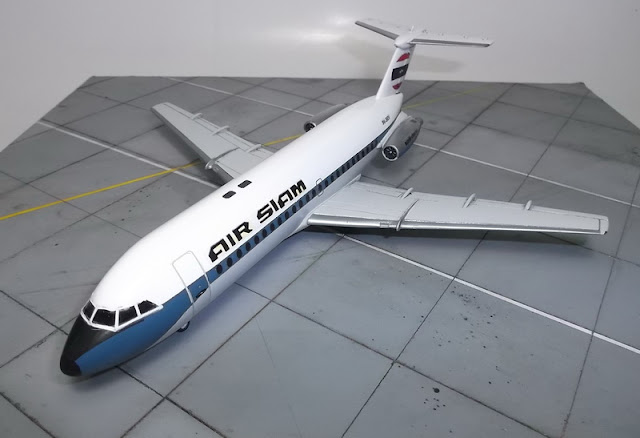Kits: Airfix Decals: DIY
Model by: Supawat Putthitornworasit Jan 2013.
The BAC One-Eleven remains in production and was the world's first short-hual jet airlines. Designed for operation at speeds of 550 m.p.h. primarily over routes of up to 1,000 miles in lenght-routes on which six out of ten air passengers travel, The One-Eleven had been ordered by eight airlines before the first flight was made on 20th August 1963. Featuring"big jet" appeal in dimension no larger than those a Viscount or a Convair airliners. The One-Eleven can operate completely independently of support equipment at small airfields. thanks to an on-board auxiliary power unit for ground cabin conditioning and engine starting. Provision is made for power operated built-in steps at the front entrance, and a ventral stairway at the rear entrance is standard equipment. Three current versions of the One-Eleven are know as Series 200,Series 300 and Series 400.All have the same dimensions and carry 63 to 70 passengers, but the Series 300 and 400 take adventage of more powerful versions of the Rolls-Royce engine to operate at higher weights and with bigger payloads, Two further developments are the Series 475 rough-field version and the large 97 seat One Eleven 500. powered by two Spey 25 Mk521's . The One-Eleven flight deck is arranged to permit operation of the aircraft by crew of two pilots. This was a major design aim in the One-Eleven and has been achieved by reducing the pilot workload to an absolute minimum and distributing it equally between the two pilots.The aircraft can be taxied,flown and controlled from either pilot's seat. The BAC 111 Series 200 is powered by a Rolls-Royce Spey turbofan engine rated at 11,000 Lb thrust providing a maximum level cruising speed of 550 m.p.h. at a maximum payload range of 1,070 miles.Wing span 88ft 6in.,Lenght 92ft 6in.
History AirSiam (from Wikipedia)
The airline was established as Varan Air-Siam on 15 September 1965 by Prince Varanand, who was the major shareholder at the time. Operations started in 1970 using Douglas DC-4 equipment, initially flying the Bangkok−Hong Kong route as a freighter service.Following and agreement with Overseas National Airways for the wet-lease of a Douglas DC-8-63 and operational assistance fromTrans World Airlines, scheduled passenger services started in March 1971 serving Bangkok, Honolulu, Tokyo and Los Angeles. All these services were suspended in January 1972; the Bangkok–Hong Kong sector was reactivated in May the same year with a leased BAC One-Eleven and extended to Tokyo seven months later, in December 1972, operated with a Boeing 707.
In April 1974, the carrier placed an order for two Airbus A300s,one A300B2 and one A300B4, taking an option for one more of the longer-range variant.After taking delivery of the first of these aircraft on a lease basis from Airbus in October 1974, Air Siam became the second operator worldwide in deploying the type on scheduled services, after Air France. Also in 1974, the company placed an order for a Douglas DC-10-30, to be used on the Bangkok–Los Angeles route. Rights for the routes the airline intended to deploy the A300s on were never granted, and the A300B2 was returned to the lessor just a year after it was incorporated into the fleet.
Before Air Siam started flying long-haul services, Thailand's flag carrier Thai International was the country's single long-haul operator. Already in 1974, the airline had accused both Thai International and the Thai Civil Aeronautics Board for obstructing their expansion plans. Despite various governments had considered the possibility of a merger, this never materialised. The new government that took office in 1976 had a different vision, and was decided for Thailand to have just one long-haul carrier.



























































